Of all the comparisons we planned for the 2017 Honda CR-V, the Mazda CX-5 might just be its toughest test.
The CX-5 is all new for 2017, with subtle improvements to a design we already loved, a more refined interior and a fresh injection of technology to a compact crossover that has long been a favorite with the AutoGuide team.
However, is it enough to top the value, practicality and efficiency of the CR-V, fresh off its victory in the AutoGuide Utility Vehicle of the Year awards?
Get the Flash Player to see this player.
Power & Efficiency
The CX-5 originally debuted in 2012, the first Mazda to be designed from the ground up with their weight-saving, performance-improving SkyActiv technology. The result was a huge success, with sales taking off thanks to its sleek looks and efficient powertrain. This time around, Mazda looked to refine its popular crossover and continue its push to a more premium experience.
While the CX-5 has never been known for its power, it has reached the point where it is competitive for the class, and it has other charms that can help you forget once you get going.
Horsepower is listed at 187, just a few shy of the CR-V’s rating, and torque is a tad better at 185 lb-ft. Although Mazda has begun to dabble in turbocharging, the CX-5’s four-cylinder is naturally aspirated and paired with a conventional six-speed automatic, delivering a quick jump thanks to an eager throttle. Power builds smoothly, but it’s a bit loud if you really push it, though it’s nowhere near as unpleasant as the CR-V.
If you’ve read any of our previous reports on the CR-V, you’ll be familiar with our appreciation for – and complaints about – the CR-V’s new engine and transmission.
ALSO SEE: 2017 Honda CR-V Long-Term Test Update: Road Trip Edition
Its 190 horsepower are entirely adequate, but it’s the 179 lb-ft of torque available from 2,000 rpm and continuously variable transmission that help get the CR-V moving smoothly if you keep throttle application light. Get on the throttle, and the engine starts to get loud, and not in a good way, overpowering the active noise cancellation tech that keeps the cabin quiet at cruising speeds.
This car just begs to be kept in Econ mode, lazily accelerating at the pace of traffic, letting the CVT maximize efficiency, which has been stellar throughout this long term test. The CX-5 is always tempting you to flick the sport switch and push it, though it gets a little too aggressive and wears thin after a while, holding gears just a bit too long.
The original CX-5 was a fuel efficiency champ, but Mazda has not raised the bar again this time around, its 26 mpg combined rating not likely to impress when compared to the CR-V’s 29. The CX-5’s city rating is 23 mpg, and out on the highway it should deliver 29 mpg, and it is a smooth highway cruiser with a buttoned-down ride and stable driving manners, and that’s before you even turn on all the driving nannies.
The CR-V is listed at 27 mpg in city driving and 33 on the highway for 29 miles per gallon combined, and since resetting the trip computer for a road trip down to the New York Auto Show, we’ve seen it stick at 29 mpg.
Compare Specs
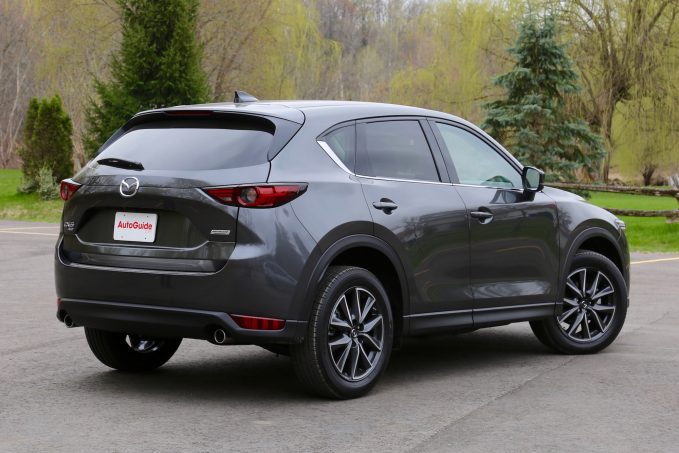
Comfort and Driving Dynamics
Although its fuel efficiency is no longer a class leader. The CX-5 lives up to Mazda’s reputation as a driver’s car, delivering the best overall driving experience in the segment, carefully balancing fun character and a comfortable ride.
Mazda worked hard on improving the ride quality and sound insulation and it is felt in may situations. The ride never feels too stiff or jittery, rolling over rough roads with just quiet thumps that are quickly controlled, and the CX-5 stays impressively flat through the corners for a compact SUV. To top it all off, it has the usual Mazda flair for drivers, with responsive steering and chassis that you’ll enjoy on twisty roads.
ALSO SEE: How the 2017 Mazda CX-5 Became as Quiet as a BMW Inside
With all our praise for the CX-5’s driving dynamics, you might think the CR-V comes out looking sluggish or disappointing, but it doesn’t.
While not quite as sharp and responsive as the CX-5, the CR-V is still smooth and comfortable, and what it gives up to the CX-5 in terms of steering and cornering isn’t likely to be felt in typical conditions driving the family hauler around to work and school and weekend activities.
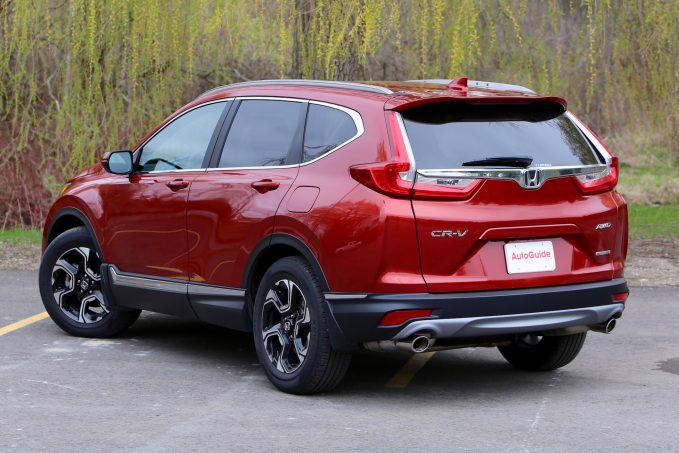
Cargo & Passenger Space
There’s no getting around the fact that the CR-V is bigger, with 39.2 cubic feet (1065L) of trunk space and 75.8 (2146 L) with the seats folded, but you might be surprised to hear that these two are virtually identical in length and width.
In fact, the CX-5 actually has a longer wheelbase, and although the CR-V has slightly better legroom on paper, it really doesn’t do justice to the amount of room in the CR-V’s back seat, with an almost flat floor that means the center position isn’t a cruel and unusual punishment.
Installing a car seat reveals that the CR-V’s door opening is a bit wider, and the extra space makes it easier to tighten all the straps or lean in and buckle up younger children, and back in the cargo area, a lower load floor will make it easier for dogs to hop up into or to load heavy items.
The Honda’s front row is just as spacious as anything in the segment and the seats are comfortable, even for long hauls. It’s only next to the CX-5 that the quality lags behind. Materials and buttons are all decent, but the leather is nowhere near as creamy, and the fake stitching on the CR-V’s dash comes off as tacky compared to the real threads in the Mazda.
ALSO SEE: 2017 Toyota RAV4 vs 2017 Mazda CX-5 Comparison
Where the CX-5 will struggle to win over compact crossover shoppers is in the practicality department.
With the rear seats up, cargo space is just 30.9 cubic feet (875 L), and doesn’t even crack 60 with the rear seats folded (1687 L). However, what it lacks in sheer volume it makes up for with a bit of flexibility.
Like the CR-V, it has release handles in the side of the trunk that allow you to drop the rear seat from the back of the vehicle. However, the CX-5’s rear seats are split 40/20/40, meaning you can drop all of it, either side, or even just the middle section so you can haul long objects like skis or two-by-fours while still able to accommodate two rear passengers or without having to remove child seats.
While the cargo space is flexible, the rear seat space is pretty tight even for a compact crossover.
The seats themselves are comfortable, and headroom is actually better than the CR-V, but legroom isn’t great, the center console juts out and a large driveline tunnel severely limit foot and knee room in the rear middle seat. For 2017, Mazda has added the option of heated rear seats and heated steering wheel.
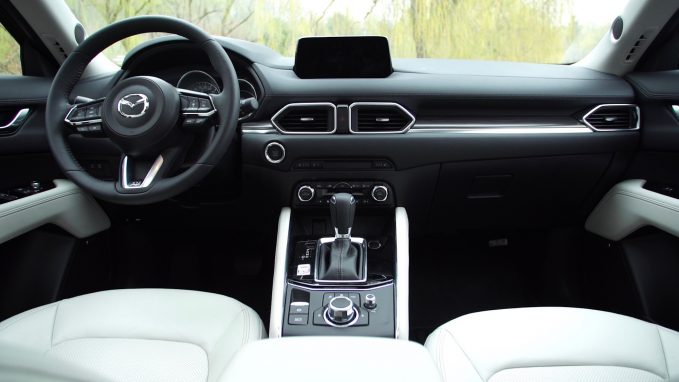
Toys and Tech
Up front, the CX-5 really comes into its own, with comfortable seats and luxurious materials you don’t expect from mainstream brands.
The CX-5 sets a new standard for interior quality, with soft touch plastics, rich leather, an attractive layout and solid switchgear.
Even the graphics on the screen are crisper and sharper, and Mazda’s console-mounted HMI controller is easy to use and response is quick, although it still seems like there are too many menus to navigate. There is a reason for all those menus, though, as the CX-5 offers tons of entertainment options like satellite radio and music apps, not to mention customization for all the driving aids, and the Mazda truly seems to have ALL the driving aids.
In addition to forward collision alert and various braking aids, Mazda has added lane-keep assist to its lane departure warning and rear cross traffic alert on higher trims to go along with a standard backup camera.
ALSO SEE: 2017 Honda CR-V vs 2017 Ford Escape
Thankfully, Mazda has also updated its adaptive cruise control to function below 18 mph, so it’ll slow right down to a crawl and even stop and go if you’re not stuck in one place for more than a couple seconds.
These updates came just in time, because the CR-V has all these helpful driving aids too, but the CX-5 has one feature that is nowhere to be seen on the CR-V – head-up display.
Rather than the little plastic screen we see on the Mazda3, the CX-5 gets a windshield-projected display in full color, with many of the driver-aid warnings joining the typical speed and route guidance info. It’s incredibly well done, and helps elevate the CX-5 above its peers as a technology leader, and does it in a way that is truly helpful and intuitive.
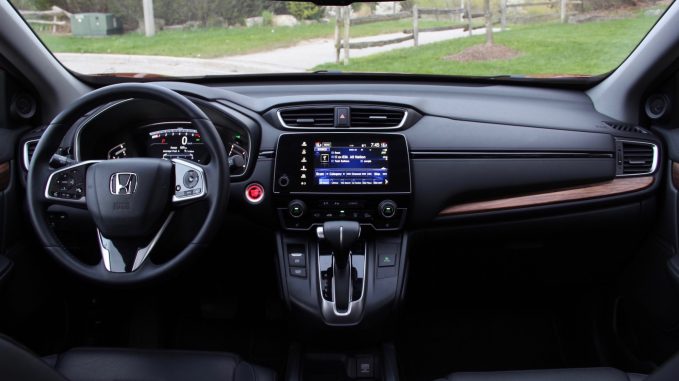
Still, a fully loaded CR-V has all the gizmos you’re likely to be looking for, and the touchscreen setup is easy to use, with great route guidance that and can even take traffic into account and help you avoid major delays.
As mentioned, both these vehicles have our favorite driving assistance features like adaptive cruise with full stop-and-go, lane keep assist, blind spot warnings, rear cross-traffic alert, forward collision warning and more, and each has ways to make these systems more or less aggressive.
The CR-V’s touchscreen system is much improved this generation, and navigating the menus has become easier over time, but we still wish it were quicker to cycle through multiple menus when digging deep in the settings menus or entering a destination (Colum Wood reports that this is much improved in the latest iteration in the 2018 Honda Odyssey). Of course, steering wheel controls and voice command mean you can avoid delays with common audio and phone functions. For those that like to switch it up occasionally, you can change the ‘skin’ of the CR-V’s screen so get a different look with all the same menus and options.
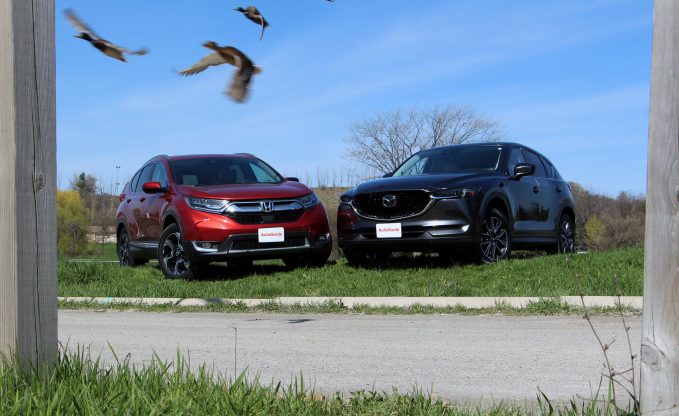
Verdict: 2017 Mazda CX-5 vs 2017 Honda CR-V Comparison Test
The CX-5 and CR-V start at an identical $24,895 (including equal $940 destination charges, too), and these fully loaded models both come in under $35,000 with the CX-5 about a grand cheaper. In Canada, the CX-5 starts at $26,795 ($1,895 freight included), while it came to $38,495 for this fully loaded GT model, but the CR-V is a bit pricier at a starting price of $28,615 ($1,725 freight included), and as tested almost cracks 40K at $39,815 .
They both have all the latest features and impressive quality throughout, and the CX-5 takes it to another level with its gorgeous looks, luxury materials and nifty head-up display. However, the CR-V is the more spacious, efficient and practical, and just as easy to drive and park, without feeling cumbersome or sloppy.
In this pairing, the CX-5 might be the better car, but the CR-V is a better utility vehicle, so it wins this comparison by the slimmest of margins and remains our compact crossover champ.



Leave a Reply